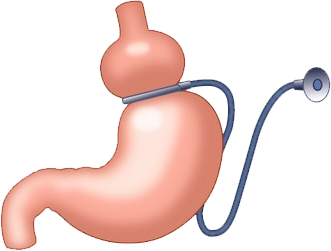Principles
This technique involves placing a modular ring around the upper part of the stomach. This creates a small pocket above the ring (20 ml) that fills up quickly, resulting in a feeling of fullness after eating relatively little food.
According to the hourglass principle, the pouch then slowly empties into the rest of the stomach, through the narrowing caused by the band, which prolongs the duration of the fullness period.
Following the procedure the band can be tightened or loosened without having to re-operate. Indeed, a balloon embedded in the band is connected by a tube to a small reservoir placed under the skin which allows the surgeon to change the diameter of the band by injecting a liquid into the reservoir through the skin.
This operation does not reduce ghrelin (hunger hormone) and does not interfere with food digestion. It reduces food intake by purely mechanical effect. The feeling of hunger is preserved but one cannot eat more than the small pocket can contain.



